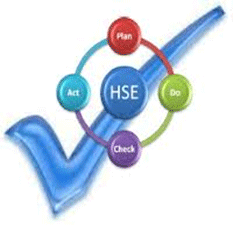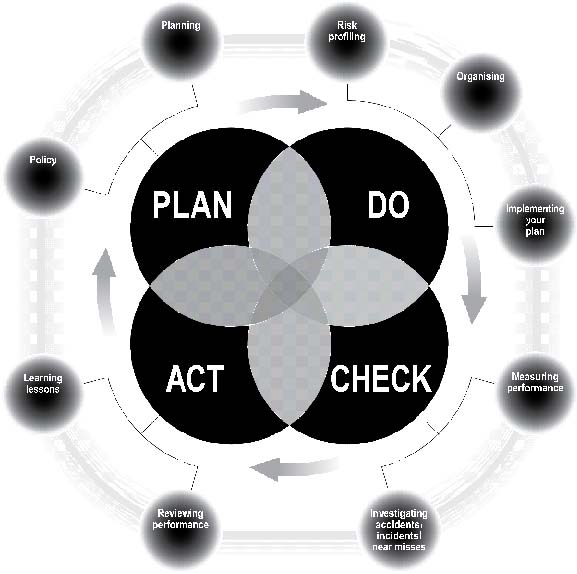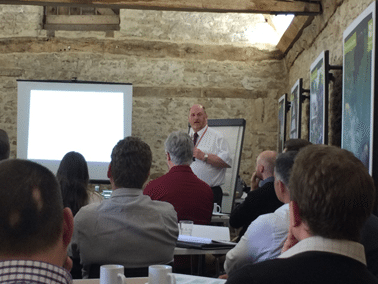We are still seeing incidents where the management of health and safety is left more to chance as opposed to having a coherent plan drawn up to oversee their company’s health and safety arrangements
So once again I thought it prudent to remind you about the HSE’s guide to Managers HSG65 and the need for proper management training.
The guidance explains the Plan, Do, Check, Act approach and shows how it can help you achieve a balance between the systems and behavioural aspects of management. It also treats health and safety management as an integral part of good management generally, rather than as a stand-alone system.
This week’s 2 recent HSE cases look at accidents where there was a lack of H&S management.
- An employee suffered fractures to 18 ribs and both wrists as well as internal injuries when he fell approximately 10 metres from a cherry picker.
- A contractor has been fined after a gas explosion at a domestic property in Lesmahagow
As ever, if you have a subject that you would like us to cover one week, please contact us by phone 01458 253682, email or via our Facebook page or by Twitter
Are you Managing safety properly?
Businesses have a legal duty to put in place suitable arrangements to manage for health and safety. This article provides a framework to help you do that effectively, in a way that your business can tailor to your own circumstances.
In implementing your arrangements, you should consult with your employees or their representatives, including trade unions where they are recognised.
The framework described in this article is universal but how far action is needed will depend on the size and nature of the organisation, and the risks from its activities, products or services.
The Plan, Do, Check, Act approach
HSE has moved away from using the POPMAR (Policy, Organising, Planning, Measuring performance, Auditing and Review) model of managing health and safety to a ‘Plan, Do, Check, Act’ approach.
The move towards Plan, Do, Check, Act achieves a balance between the systems and behavioural aspects of management. It also treats health and safety management as an integral part of good management generally, rather than as a stand-alone system.
The high-level descriptions may vary, depending on the industry or sector you are working in, but a summary of the actions involved in delivering effective arrangements and how they are frequently described is given in Table 1, under the headings of Plan, Do, Check, Act.
| Plan, Do, Check, Act | Conventional health and safety management | Process safety | ||||
|---|---|---|---|---|---|---|
| Plan | Determine your policy/Plan for implementation | Define and communicate acceptable performance and resources needed | ||||
| Do | Profile risks/Organise for health and safety/Implement your plan |
| ||||
| Check | Measure performance (monitor before events, investigate after events) | Measure and review performance/Learn from measurements and findings of investigations | ||||
| Act | Review performance/Act on | Measure and review performance/Learn from measurements and findings of investigations |
Plan
- Think about where you are now and where you need to be.
- Say what you want to achieve, who will be responsible for what, how you will achieve your aims, and how you will measure your success. You may need to write down this policy and your plan to deliver it.
- Decide how you will measure performance. Think about ways to do this that go beyond looking at accident figures; look for leading indicators as well as lagging indicators. These are also called active and reactive indicators.
- Consider fire and other emergencies. Co-operate with anyone who shares your workplace and co-ordinate plans with them.
- Remember to plan for changes and identify any specific legal requirements that apply to you.
Do
- Identify your risk profile
- Assess the risks, identify what could cause harm in the workplace, who it could harm and how, and what you will do to manage the risk.
- Decide what the priorities are and identify the biggest risks.
- Organise your activities to deliver your plan
In particular, aim to:
- Involve workers and communicate, so that everyone is clear on what is needed and can discuss issues – develop positive attitudes and behaviours.
- Provide adequate resources, including competent advice where needed.
- Implement your plan
- Decide on the preventive and protective measures needed and put them in place.
- Provide the right tools and equipment to do the job and keep them maintained.
- Train and instruct, to ensure everyone is competent to carry out their work.
- Supervise to make sure that arrangements are followed.
Check
- Measure your performance
- Make sure that your plan has been implemented – ‘paperwork’ on its own is not a good performance measure.
- Assess how well the risks are being controlled and if you are achieving your aims. In some circumstances formal audits may be useful.
- Investigate the causes of accidents, incidents or near misses
Act
- Review your performance
- Learn from accidents and incidents, ill-health data, errors and relevant experience, including from other organisations.
- Revisit plans, policy documents and risk assessments to see if they need updating.
- Take action on lessons learned, including from audit and inspection reports
The Plan, Do, Check, Act cycle
Plan, Do, Check, Act should not be seen as a once-and-for-all action:

You may need to go round the cycle more than once, particularly when:
- starting out;
- developing a new process, product or service; or
- implementing any change.
Whatever your industry, or the size or nature of your organisation, the keys to effectively managing for health and safety are:
- leadership and management (including appropriate business processes);
- a trained/skilled workforce;
- an environment where people are trusted and involved.
HSE advocates that all of these elements, underpinned by an understanding of the profile of risks the organisation creates or faces, are needed
Legal duties
All organisations have management processes or arrangements to deal with payroll, personnel issues, finance and quality control – managing health and safety is no different.
The Management of Health and Safety at Work Regulations 1999 require employers to put in place arrangements to control health and safety risks. As a minimum, you should have the processes and procedures required to meet the legal requirements, including:
- a written health and safety policy (if you employ five or more people);
- assessments of the risks to employees, contractors, customers, partners, and any other people who could be affected by your activities – and record the significant findings in writing (if you employ five or more people). Any risk assessment must be ‘suitable and sufficient’;
- arrangements for the effective planning, organisation, control, monitoring and review of the preventive and protective measures that come from risk assessment;
- access to competent health and safety advice, such as The Wilkins Safety Group;
- providing employees with information about the risks in your workplace and how they are protected;
- instruction and training for employees in how to deal with the risks;
- ensuring there is adequate and appropriate supervision in place;
- consulting with employees about their risks at work and current preventive and protective measures.
Leading and managing for health and safety
Judith Hackitt, HSE Chair recently said:
‘There is a need for a sensible and proportionate approach to risk management, in short, a balanced approach – this means ensuring that paperwork is proportionate, does not get in the way of doing the job, and it certainly does not mean risk elimination at all costs.’
Leaders, at all levels, need to understand the range of health and safety risks in their part of the organisation and to give proportionate attention to each of them. This applies to the level of detail and effort put into assessing the risks, implementing controls, supervising and monitoring.
If you would like any further help or support, please please contact us by phone 01458 253682, email, or via our Facebook page or by Twitter.
Taunton & Somerset CPD Group at The Exchange House Taunton
Please note our new venue.
From now on we are intending to run these CPD events at the Exchange House, 12 – 14 The Crescent, Taunton TA1 4EB.
The next of the CPD events is listed below.
As previously requested, if you could let us know whether or not you can attend it would be greatly appreciated. Also, if you would like to give a talk, or know of somebody who would, please contact Jon at [email protected]
Our next Seminar will be on Wednesday 21st February 2018. Could you please arrive by 12:30pm prompt.
Our speaker for this one is Amber Hatten from Tobermore, Paving and Walling Specialists, and you can download a PDF here on what Amber is going to talk about.
If you haven’t already booked your place, or if you are not on the CPD Seminar mailing list but would like to be please drop Jon an email and he will deal with your request.
As per our last one if you could let Jon know whether or not you can attend within 7 days of receipt of his email, it would be greatly appreciated.
Advance notice of next seminars:
March Seminar on 21st March and will be Nick Hunt of Cupa Slate to talk about Specifying Natural Roofing Slate
April Seminar 0n 11th April will be Amwell Systems Ltd with their recently updated RIBA approved CPD Innovation in Flush Fronted Washrooms.
Contact Details [email protected] 07831 714199 or 01458 253682
Training Courses
We shall be running new courses again in 2018 and the dates and details of forthcoming courses will be published here each week.
But remember we are still available for running “In House” courses and are looking to add new training courses to our list.
If you have any questions about these courses or any other training or would like us to run a particular course for you, call Jon Wilkins of the Wilkins Safety Group on 01458 253682 or email him at [email protected]
You will note that one of these courses is the 2-day Level 2 course in Supervising Staff Safely which you and your managers should attend in order to help you manage your safety properly!
Courses available for booking now
- BSC Level 1 Award Health and Safety in a Construction Environment
- CDM Regulations 2015 – An Awareness Course
- Level 2 Award in Supervising Staff Safely
- Treating Health like Safety
- Asbestos Awareness
